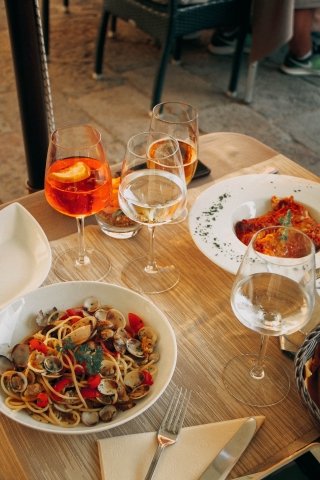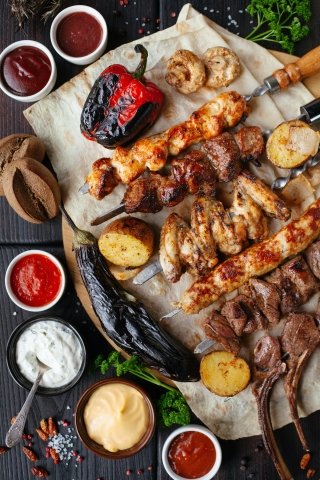
Indulge in local delights on your summer villa holiday
Travelling to one of our Mediterranean villas comes with some guarantees. The weather will be rejuvenating, the views will be one of a kind, and the food on offer will be like nothing you've tried before. With 25% of people travelling abroad for cultural and food-related purposes, one of the best things about Mediterranean cuisine is the variety found in local dishes. If you plan on exploring the region around your villa, expect to find family recipes, local traditions and various adjustments claiming to be the most authentic.
Authentic or otherwise, with playful flavours, precise seasoning and spectacular surroundings, the Mediterranean is undoubtedly home to some of Europe's most sumptuous meals. We share some of our favourite cuisines we've encountered while on the shores of Europe's most scenic destinations.
Italy
Italian cuisine is without a doubt one of the most significant cultural exports to come from this boot-shaped country. Pizza, pasta, Italian cheeses and meats are found today across the globe and for good reason; Italian dishes are some of the heartiest, most comforting dishes you can find in Mediterranean cuisines. Not only this, but the Italians are proud of their food, meal times are sacred, and fresh ingredients and quality produce are core tenets of the Italian kitchen.
With so many fantastic Italian restaurants at home and around the world, when you stay at one of our Italian villas, make the most of the opportunity to try dishes you might otherwise not have access to. Regional dishes that make use of local ingredients include the iconic Tuscan pasta dish, tagliatelle al tartufo, a meal consisting of ribbons of tagliatelle coated in garlic butter and topped with parmigiano cheese and a regional speciality, black truffles.
Pasta dishes are everywhere, and with such variety in shape, thickness and texture, it can feel as though every town has developed their version of this versatile staple. On the island of Sardinia, you can expect to find a pasta called malloreddus, a ribbed shell-shaped pasta. In contrast, Puglia is home to a round, dimpled pasta known as orecchiette. Meats and fish dishes vary just as much, the only consistency being their mouth-watering flavour!

Greece
Greece, like most of the Mediterranean, is home to a cuisine that treats wheat, olive oil and wine as its foundation. Located in the eastern half of the Mediterranean but connected for thousands of years with the western half via trade and diplomacy, Greece has a strong culinary identity that takes influence from both sides of the Med to create a unique and instantly identifiable set of dishes.
Much like Italy, Greece's dishes are often localised, resulting from its island culture and the accessibility of ingredients. Traditional Greek cuisine exemplifies the Mediterranean diet, with a focus on vegetables, fish and olive oil. However, today meat is much more common and is readily available in restaurants around the country. The running theme of Greek cuisine is the outside influences that have resulted in the iconic dishes we know and enjoy today!
If you're enjoying your stay in a villa at one of the Ionian islands, including Lefkas, Kefalonia and Zakynthos, you can expect to find an Italian influence in the food due to the centuries of Venetian rule. Other islands, such as the Rhodes and Kos, contain Turkish or Ottoman influences in their food, adding tzatziki, pita bread and baklava, among countless others. In Crete, traditional cuisine revolves around the use of fresh vegetables, poultry and fish. Olive oil and red wine accompany almost every dish, though for different purposes!

Portugal
Browse a menu in the Algarve, and you'll see a cuisine that features seafood, spices and olive oil. Bordered on two sides by the Atlantic and the Mediterranean, the Portuguese have long used seafood in their dishes with some ingredients, such as salted cod, or bacalhau, becoming famous worldwide. Chances are, when dining out in Portugal, you will encounter bacalhau in one form or another. According to some, there are 1001 recipes for Portugal's iconic ingredient, so variations are plenty, and we recommend sampling several!
Another of Portugal's famous foods is the Portuguese tart, or the pasteis de nata, a sweet custard tart popular across Portugal and Europe. Naturally, the original and best pasteis de nata are found in Portugal, in Lisbon. You can expect to see queues lining out the door of Pastéis de Belém, a bakery from 1837 that holds the secret recipe to the original custard tarts.
As much as fish and seafood are a staple of the Portuguese diet, meat plays a vital role in many of the region's dishes. Iberian black pigs are a typical delicacy in Portugal, where their diet of acorns results in a unique and delicious flavour. You can enjoy the ham in a variety of ways, whether it's paper-thin slices of cured ham or pork cutlets - these pigs are the stars of plenty of plates. Similarly, In Madeira, you can find carne de vinha d'alhos, a pork dish marinated in a garlic sauce and served traditionally at Christmas, though today is available all year round.

Dining in the Mediterranean
With so much fantastic food at your fingertips, it can be hard to know where to start when you first dine out after arriving at your villa. It can be worth researching which dishes you're most interested in and where you can find them. It may also be worth making reservations at popular restaurants if you expect them to be busy or unable to accommodate you.
If you're travelling on a family holiday with some fussy eaters, you needn't fret! Almost all restaurants will have something a little more familiar for less adventurous palates. Also, should you want to prepare your own food, all of our villas come with fully equipped kitchens.
If you'd like to know more about booking one of our villas you can contact us here for more details on our wide range of holiday villas in the Mediterranean.

